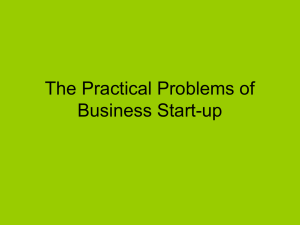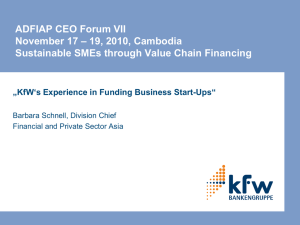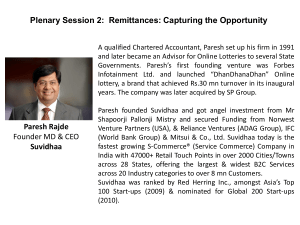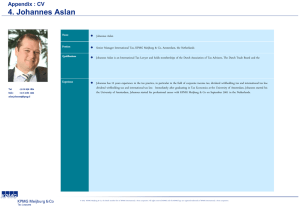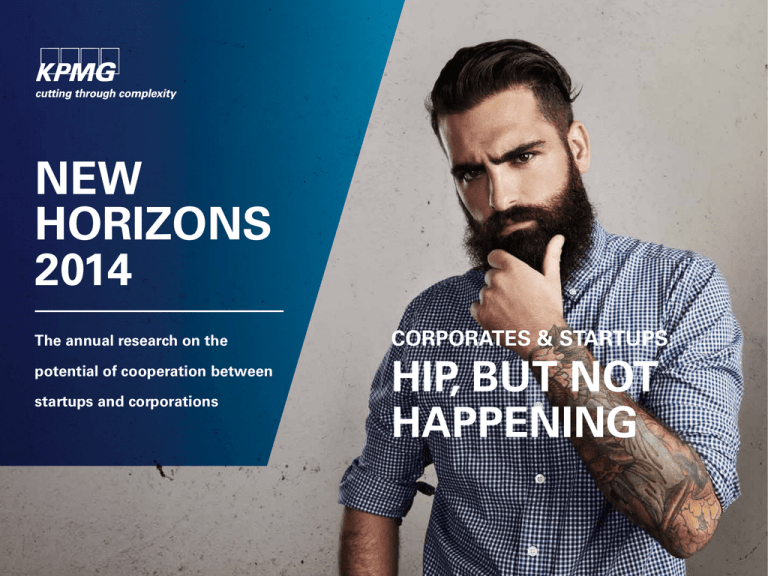
New
Horizons
2014
The annual research on the
potential of cooperation between
startups and corporations
Corporates & Startups:
Hip, but not
happening
New Horizons
Table of contents
03
chapter 1
17
chapter 3
07
Interview Michel Pozas Lucic
20
Interview Arjan van Os
10
14
© 2014 KPMG N.V.
Wake up call
Time to face the
music and dance
Don’t wait till the
robot’s over its
teething troubles
chapter 2
key findings
Interview Lassi Kurkijärvi
SanomaLab’s goal:
to make itself
redundant
23
24
Doing is the
best kind of
thinking
We see ourselves
as a start-up chapter 4
Epilogue
Interview Daan Weddepohl
Ambassadors of
the community drill
/2
New Horizons
chapTer 1
Wake up call
Time To face
The music and
dance
EDO ROOS lINDGREEN
HEAD OF INNOvATION KPMG NETHERlANDS
© 2014 KPMG N.V.
/3
New Horizons
A
new reality is upon the business world. We
are living in a time where size no longer
equals power. A time where imagination
is coming into power and creativity is the only
relevant lifeline to the future. A time where there is
patently more to be gained from collaboration than
from the traditional hierarchic forms of working. A
time where technological innovation is more or less
turning all sectors upside down. A time where there
are almost no guarantees any more and where trial
and error may well be the only remaining strategy.
A time of exponential acceleration on many fronts
simultaneously.
You are bound to have seen it for yourself, so we
need not linger too long over what this new reality
looks like. What we do want to discuss in more
detail is the role played by start-ups in this paradigm.
They feel perfectly at home in this new reality; in
fact, they’re basically the ones who designed it. They
see infinite opportunities to make the world function
better, improve customer experiences and set up
new business models. They set foot in this new
world with a combination of unbridled enthusiasm,
© 2014 KPMG N.V.
/4
extreme focus, great personal drive and sometimes
a dash of naiveté and idealism. They often fail. But
they also set an enormous wave of innovation in
motion, one which strikes terror into the traditional
companies.
Well-known examples which have taken hard hits
are the taxi business – assailed by Uber – and
the travel industry – under siege by Airbnb and
others. Yet disruption does not stop at these usual
suspects. While the gradual destabilisation in
other sectors may be less perceptible, that does
not mean it is not there. Take our own sector. It is
almost certain that someone, somewhere, at this
very moment, is developing an algorithm as a great
alternative to take over the audit using data analysis.
The question is whether we are prepared and what
will we do if this scenario unfolds?
New Horizons
Apple killed Finland
It’s a rhetorical question which every large
company must ask itself. And the answer to
that question must lead to action, for the lack of
timely action can prove fatal – just like that, no
messing about. ‘Apple killed Finland’ was what
the president of Finland said earlier this year in
reference to the dive taken by Nokia and the
paper industry, the two mainstays of the Finnish
economy. This is a scenario which can unfold
for any corporate if they ignore the new reality,
which is being built primarily by start-ups. The
good news is that this scenario can be avoided.
Because corporates themselves can sit down at
the drawing board of the new reality rather than
waiting to be caught off guard. So how well have
they been doing in this sense?
Collaboration between corporates
and start-ups mainly superficial
Our conclusion in the second edition of our annual
New Horizons report: on the face of it, the worlds
seem avidly engaged in sounding each other out.
Yet closer observation reveals loads of window
dressing, as collaboration is frequently sought in
‘easy’ territory only rather than as a way to crack
© 2014 KPMG N.V.
major strategic problems. And apart from a group
of corporate forerunners – who are engaged with
start-ups – there is a large pack of corporates
that are still rubbing the sleep from their eyes as
they slowly begin to see the necessity of having
connections with the community of start-ups.
Read: that it’s all right – indeed imperative – for
them to sit down at the drawing table as well. They
simply have not been doing enough, do not feel
the urgency or are content to pass the buck to the
periphery of the organisation.
This is perhaps understandable, for they have
their hands full with their short-term challenges
and the pressure to keep the financial results
straightened out. Yet such a ‘penny wise, pound
foolish’ attitude is also the best recipe for getting
overtaken by reality. Existing companies – from
multinational corporations to local, family-run
businesses – must embrace the new world. And
that is only possible if they immerse themselves
along with those businesses where the new world
is created. For as one of the interviewees put it:
‘It’s an illusion to think that you, as
/5
New Horizons
a big multinational corporation,
can attract the smartest and
most creative minds on your own.’
‘A US study has
shown that
collaboration
simply produces
better results than
competition’
That makes seamless collaboration with
communities the name of the game. A group
of corporate forerunners have immersed
themselves in this community. They forge
alliances with start-ups, have started to
experiment and are open to all different kinds
of collaboration. Even if the business case still
needs some finishing touches or if the exact
possibilities have yet to take shape: it does not
hold them back. Not even if things are still up in
the air as to how the value of potential success is
to be divided between them.
Yet the majority are still barely up to it – if at all
– and are in danger of falling by the wayside. So
they are risking a lot: their right to exist. As far as
we are concerned, the message to them is clear:
It’s time to face the music and
dance. Together.
Incidentally, this conclusion is based on more
than just our own observations and this survey
© 2014 KPMG N.V.
/6
amongst start-ups and corporates. It is also
based on studies which show that collaboration
is much more efficient than the traditional
hierarchic approach where competition is king.
A US study1 has shown that collaboration simply
produces better results than competition. It is
more enjoyable, gives people self-confidence and
stimulates their sense of responsibility. That is
exactly what many corporates need. Once they
are in an adequate position to join in with the
corporate community, that’s when they take back
control of their future.
Simple? Certainly not. Farther down in this
publication (in chapter 3) we share several
experiences which could be helpful. But let us
begin by going through the key findings of our
study.
Edo Roos Lindgreen
Head of Innovation
KPMG Netherlands
http://www.co-operation.org/wp-content/uploads/2011/01/
ER.CL-Success-Story-Pub-Version-09.pdf
1
New Horizons
inTervieW
don’T WaiT Till
The roboT’s over
iTs TeeThing
Troubles
MICHEl POzAS lUCIC – vICE PRESIDENT
OF CORPORATE STRATEGy & INNOvATION
© 2014
© 2014
KPMG
KPMG
N.V. N.V.
/7
New Horizons
Y
ou can’t buy innovation. Wait on the
side-lines until a technology is marketready, and you will find yourself lagging
hopelessly behind. By then the deals in the
market will have been done, with your company
left ill-prepared for the future. That makes it vital
to be actively involved in the world of disruptive
technologies. This is serious business for Michel
Pozas Lucic – Vice President of Corporate
Strategy & Innovation – at Air France-KLM.
‘It’s clear that robotics will have a major impact
on the aviation industry in the next ten years. But
exactly how? And at what pace will robots be put
into use? That we don’t know. But what we do
know is that we cannot wait around for an answer.
If we bide our time until the robot is ready and
over its teething troubles, then it may already be
too late. By then, the deals in the market will be
done, with no room left for us. Well, so much for
capitalising on the opportunities the new world
has to offer! Moreover, getting involved in robotics
means adapting one’s organisation and processes
to its development. Staff must be instructed in
how to use, program and maintain those robots.
That takes time, so we can’t afford to wait until the
robots are delivered to the doorstep, as it were.
© 2014 KPMG N.V.
Consequently, we need to stay on top of the
current disruptions and join in the experiment.
We must – and truly desire to – be explicitly
involved in those start-ups responsible for most
of the disruption. How? Through our devotion to
a variety of networks, accelerators and events.
We scout out and screen hundreds of start-ups a
year. And we invest via the Mainport Innovation
Fund in start-ups that can help us. One good
example is a particular innovation for tracking
luggage. Using a special tag linked to an app,
travellers can see where their luggage is at all
times and, if required, they can even change
its destination. Yet we also co-create with other
major companies. For example, in September
we held the largest big data hackathon in the
Netherlands.
As a major company, it’s important to stay on top
of global trends, and I don’t just mean trends in
our own industry. The biggest disruptions often
come from other industries, especially now that
technological developments are driving change
at an exponential rate. Robotics, retail and big
data are just a few of our focuses. These areas
are the result of an intensive process we went
through last year. We started by identifying
/8
200 trends, conducted market surveys, forced
ourselves to look five to ten years ahead and
then came up with 23 hot trends as a result. It
turned out three of them had somewhat slipped
under our radar, so that was obviously where we
needed to focus next. Yet we also realised there
were certain key trends where we had actually
been doing rather well with strategic innovation.
For instance, in recent years we have become
the global leader in biofuel and sustainability.
Of course I can see that the world of start-ups is
completely different to the world of the average
corporation. In my opinion this is not so much a
difference of ideals but more a different way of
working to achieve those ideals. A corporation
traditionally works on the basis of business
cases. A start-up works more according to the
mantra of “fail fast and cheap”. For us, the
challenge is to adopt that approach at Air FranceKLM. That’s difficult, especially in aviation where
a solid approach is part of our DNA, if only
because safety is always our top priority. On the
other hand, we can ramp up quite quickly if we
really have our sights set on something.
New Horizons
/9
If we want to feel confident about our future, we
really do need to embrace how start-ups work and
think. What we’ve learnt is that it sometimes takes
up to two years to get true collaboration off the
ground. We’ve also seen that the really early-stage
start-ups sometimes lack the maturity. But we are
making good headway and have had some success.
We still have a long way to go and much to do. We
make a point of organising events in the company
to share the energy and stories on our collaborative
efforts with start-ups. By all means, this ought not to
be done in isolation. At any rate, corporations should
avoid thinking in terms of “big and powerful”.That’s
the old way of thinking. It’s an illusion for any one
company to think they’ve managed to pluck the best
and brightest 100 people from the market.
‘What we’ve
learnt is that
it sometimes
takes up to two
years to get true
collaboration off
the ground.’
© 2014 KPMG N.V.
We can and must learn from other businesses and
more specifically from start-ups. But the same goes
the other way around. I quite often see start-ups who
haven’t given much thought to their earnings model.
That might sound hip and trendy, but you won’t get
far like that. Experience shows that those start-ups
often don’t make it. But, generally, it’s my experience
that start-ups are often good in technology but poor
in business and organisation. And that’s exactly
where we can prove our great value.’
New Horizons
chapTer 2
key findings
© 2014 KPMG N.V.
/ 10
New Horizons
© 2014 KPMG N.V.
/ 11
New Horizons
The study in a nutshell
New Horizons is the name of the
study conducted by KPMG for the
second time in autumn 2014 on the
collaboration between corporates
and start-ups in the Netherlands. Our
study comprised an online survey and
in-depth personal interviews amongst
the founders of start-ups (technology
sector) as well as chief innovation
officers/managers and strategists of
large (listed) companies. The response
was 72 surveys amongst start-ups
and 32 amongst large companies.
In addition, we conducted dozens of
personal interviews with start-ups
and large companies. This publication
gives a full account of four of those
interviews. The key findings of our
study are presented in this chapter.
1. No lack of appetite for
collaboration
• There are scores of initiatives – ranging from
accelerator programmes to hackathons and
awards – which show that start-ups are hot
in the business establishment. The results
of the study confirm this as well. More than
70% of all start-ups surveyed (71%) agree that
collaboration with corporates is necessary for
success.
• And as much as 88% of all corporates
surveyed are of the opinion that they must
collaborate with start-ups in order to innovate.
• As the main reason, 94% of all corporates
say that collaboration increases their capacity
to innovate. On the side of the start-ups, the
main reason to work together is to achieve
greater legitimacy in the market (87%).
• At the same time, collaboration is no easy
task for corporates in particular; 56% say it is
difficult to find the right start-ups.
‘56% say it is difficult
to find the right
start-ups.’
© 2014 KPMG N.V.
/ 12
2. Collaboration between corporates
and start-ups mainly superficial
• Corporates and start-ups can strengthen each
other in key areas to tackle the new business
reality successfully. For corporates, new
concepts and techniques from start-ups can
be a way to remain relevant in a changing
world. In return, corporates can give startups the power to scale up, for example. Yet
the reality – as shown by various questions
in the survey – is that most collaboration is
superficial, with little actual teamwork in such
important areas.
• The reason to work together is e.g. rather
‘unsophisticated’: here the most important
factors by far for corporates and start-ups are
‘access to distribution channels’ (important to
97% of corporates and 86% of start-ups) and
‘access to market’ (cited by 94% of corporates
and 90% of start-ups). Not exactly an
indication of intensive, extensive collaboration.
• That also goes for the type of collaboration.
Traditional forms of collaboration such as a
customer/supplier relationship and licensing
are the most dominant by far. When asked
to name the top three current governance
New Horizons
‘we can see that
collaboration is not
yet at the heart of
strategy.’
© 2014 KPMG N.V.
models, the customer/supplier model is ranked
number one by 35% of all respondents, both
corporates and start-ups. On the other hand, an
extensive form of franchising is mentioned by
only 1% of all respondents.
• From another question, we can see that
collaboration is not yet at the heart of strategy.
For instance, both sides think it is particularly
important to keep focusing on their own
mission (88% of all respondents) and on
independence in their collaboration (83%).
These are indications that they are still very
wary.
• And finally, one last finding that backs this
up: when asked if it would ‘sting’ if their
collaboration were to fail today, only 27% of the
corporates answered in the affirmative. At 65%,
this rate is much higher amongst start-ups.
/ 13
3.Still some big differences
Without a doubt, the difference between the
world of start-ups and the world of corporates is
like night and day. The corporates and start-ups
concur. In their experience, the main hurdles are
indecisiveness (90% of all start-ups agree that
this is a problem) and bureaucracy/red tape (84%
agreement). In addition, start-ups find it difficult
to find the right person within a corporate (72%
agreement). Corporates, on the other hand, see a
lack of maturity amongst start-up as an obstacle
(44%) and too much focus on the product (36%
agreement).
New Horizons
inTervieW
sanomalab’s
goal: To
make iTself
redundanT
lASSI KURKIJÄRvI
© 2014 KPMG N.V.
/ 14
New Horizons
I
nnovation in large companies has its
limitations. Incremental improvements and
efficiency gains: that’s about the extent of
it. Yet what is far more important is to develop
new applications and products that customers
want. Lassi Kurkijärvi has placed his bets on the
latter with SanomaLab, where he is creating an
environment in which employees can achieve
great things.
most unexpected staff! Motivated people are a
thousand times more effective than unmotivated
people.
The real challenge, of course, is to develop
new applications that people really want.
Innovation is more about understanding human
behaviour than about technology. What makes
it even more difficult is that human behaviour
changes so quickly. The world can change
completely overnight while we are asleep.
So we are doing everything in our ability to get
the conditions just right. At SanomaLab we apply
numerous insights and methods from the world
of start-ups. One of those is the lean start-up
method, which helps us to arrive at an endproduct gradually rather than hammering out all
the details up front. The ideas that we pick up
along the way come to us via various channels:
from our incubator programme, the business
or our own lab. We also have a venture fund
which can be used for investing in start-ups.
We therefore take both the internal and external
route and of course coordinate our efforts.
This calls for a different approach to innovation.
In my opinion, conditions must be created in
which employees can fulfil their full potential
and where they are motivated to develop new
business, make the world better and make life
more pleasant. People can achieve great things
when they are motivated and given room for
their ideas. Before you know it, you will see the
greatest accomplishments coming from the
One thing we’ve noticed is the high success rate
among our female colleagues: relatively speaking,
a much higher proportion than in the world of
start-ups. The cause of this isn’t entirely clear,
but I wouldn’t be surprised if it had something
to do with the somewhat ‘hard’, ‘masculine’
environment in which a starting entrepreneur
has to find their way. Perhaps women feel more
comfortable in an environment like SanomaLab.
© 2014 KPMG N.V.
/ 15
We have been up and running for almost a year
now and have developed numerous tangible
results with the help of the lab. One example
is SpotnShop, a fashion community. When
consumers see a fashion item on the street
or in the media, they can simply upload a
photo and ask the community where it can be
purchased. This seems to be working well: the
community already has 60,000 users. We are
now developing a proper business model to go
with it.
Thanks to the lab, we can bring the start-up
mentality to Sanoma. The result is the best of
both worlds. On the one hand, the energy and
speed of a start-up; on the other, the clout of a
major company. Recently we were working on
a new idea for a loyalty card in Finland. Then it
certainly makes things easier when you can sit
down with the payment providers as a major
company.
If everything goes to plan, this lab will no longer
exist in five years. It’s actually a vehicle to set
the transformation of the entire company in
motion. We are making good progress, but at
the same time it can be a bit scary. We have all
New Horizons
/ 16
the conditions to succeed: there is a will to change,
sponsorship from the top and we have good people.
So if things do go pear-shaped, that won’t be the
reason why. But I still can’t give any guarantees,
except to say we are working extremely hard.
‘We are making good
progress, but at the
same time it can be a
bit scary.’
© 2014 KPMG N.V.
It won’t happen on its own, of course, and there
will be some resistance along the way. But that’s
actually a good thing because those discussions will
be a great reality check. We understand all too well
that we must invest in relationships throughout the
entire company. The main task of one of our people
– we call him “the hustler” – is to have a coffee with
people and strike up those conversations. It’s all
about taking as many people as possible along on
your journey.
New Horizons
chapTer 3
doing is The
besT kind of
2
Thinking
poTenTial sTeps for
producTive collaboraTion
WiTh sTarT-ups
2
© 2014 KPMG N.V.
Taken from TED Talk by Tom Chi: http://blog.ted.com/2013/02/01/
google-glass-prototyped-using-binder-clips-and-clay/
/ 17
New Horizons
Aware of differences
When we talk about the world of start-ups
versus the world of corporates, that is actually a
gross misunderstanding of reality. Because there
is no such thing as an archetypal start-up or even
an archetypal corporation for that matter: there’s
a sliding scale with some companies more
towards one end and some more towards the
other. Nevertheless, the differences can be big.
Firstly, start-ups are often very fast at taking
decisions, striking out a new course and
jettisoning things that do not work. At that pace,
corporates are often unable to keep up. One of
the interviewees compared this to a GTI versus
a diesel.
‘understanding these
differences is the
first important step
towards success.’
© 2014 KPMG N.V.
The business motives differ as well. In the
corporate world, emphasis is often placed on
business continuity and expansion, with new
initiatives being held up to a business case.
Start-ups have a stronger, often personal, drive
to success, which is down to various reasons,
ranging from the desire to get rich to the ideal of
contributing to a better world.
/ 18
Finally, corporates are often quite limited by a
multitude of conditions in their own organisation.
They are trapped in their own system, as it were.
Start-ups on the other hand are free: they can still
shape their own system.
Understanding these differences is the first
important step towards success.
What to do
Based on the interviews and our own experiences,
there are five main points that corporates should
focus on:
1 Actively search for a connection
and build your competences to that
end
Corporates that struggle to work with small
companies and systemically close the gates for
start-ups will lose sync with the world around
them. They must actively seek a connection with
an ecosystem of small players. That means looking
for inspiration about where potential disruption
comes from, in order to understand where the
risks of disrupting the current business model lie
and also where the opportunities can be found.
New Horizons
Yet by all means, this must be more than
just a non-committal exercise. What we see
from the study is that collaboration is much
more common for companies with a market
and sales focus and much more difficult for
those focusing on innovation and strategy.
Nevertheless, this is where the real challenge
lies.
To avoid being outpaced, it is time to develop
the capability to work with start-ups. Large
organisations need to understand that for
a start-up, every minute counts. Time and
decisiveness are of the essence.
2 Create an open culture and use
connectors
It takes two to tango. To make a good
connection to the ecosystem, the corporate
side needs to work on a culture that is open
to experimenting and collaborating with
start-ups. This ensures that there is at least
fertile soil. Without it, there is a huge risk that
collaboration with a promising start-up will be
short-lived. Various experiments and forms of
working can be used to target this process.
© 2014 KPMG N.V.
In addition, good bridge builders are crucial
to enable the corporate world and the world
of start-ups to work together. Matchmakers –
both internal and external – understand both
worlds and can ensure that the right doors are
opened and that the procedures and systems
do not stand in the way of further collaboration.
3 Secure top level support
It might be the worst cliché in the world, but
it’s the truth: without commitment and support
from the top of the organisation, collaboration
with start-ups will probably never flourish. That
means taking managing directors out of their
comfort zone and making them wake up to the
world of start-ups. Here it is important to realise
that board members are, by nature, primarily
concerned with stability within the company in
the short term; watersheds are not exactly their
business. One thing that certainly won’t help
to alter their perception is to cry even louder
that the world is changing. What does work is
to offer them experiences where they can see
that for themselves. Incidentally, supervisory
directors can play a role here: after all, they are
the ones responsible for long-term continuity.
/ 19
4 Think like a venture capitalist
VCs invest in 10 out of every 1,000 companies
they meet. In most cases, one or two of those
companies bring in large returns, up to 10 to 15
times the return on investment in five to seven
years. Applying this approach to corporate
engagement with start-ups makes sense. As a
consequence, corporates should:
1) meet a lot of potential collaboration partners,
2) build long-term alliances with a selection of
them and have the confidence and patience
to realise returns. Innovation teams need to
build their business case based on a portfolio
of start-up alliances instead of one business
case per start-up initiative. For instance, we
will embark on ten start-up collaborations this
coming year, and we believe that one of these
experiments will lead to a new product.
New Horizons
inTervieW
We see
ourselves
as a sTarT-up
© 2014 KPMG N.V.
ARJAN vAN OS
/ 20
New Horizons
A
rjan van Os leads the ABN AMRO
Innovation Centre. The objective of this
vibrant and colourful micro-cosmos in
Amsterdam’s South Axis business district is to
make the whole company feel that innovation is
the ultimate fuel for its future success, and to
build a culture where new ideas are nurtured,
not rejected.
‘There are several things that make the financial
world unique. One of these is the long horizon
of the classic S-curve. As a function of how a
company has to reinvent itself over and over
in order to reach the top, this curve has had a
much longer horizon for the financial world in
recent decades than for many other industries.
So bankers are not exactly accustomed to
reinventing themselves. This of course has an
enormous impact on an organisation’s culture
and attitude to innovation. At the same time, a
new reality is clearly upon us. Disruptive forces
are at play on different fronts, and they cannot
be ignored. Start-ups are a good example of
how to get to grips with disruption. They have a
good appreciation of disruption and develop new
concepts to make it work in their favour. That fills
us with inspiration, which is why we are so keen
© 2014 KPMG N.V.
to apply their ideas and way of working in our
own environment. But that doesn’t just happen
on its own – if only because we, as a bank, have
a completely different history to that of a startup. Start-ups come up with an idea to improve
the world, go after it and sometimes don’t get
around to thinking about their earnings model
until later. Such an approach is less natural for
a bank, and the ultimate formula for success
on how to reconcile these worlds still eludes
me. As a bank, we have to work on ourselves
to create the right culture. We are making good
headway and learning every day.
We have made a point of taking the ideas and
energy of start-ups on board here, for example
by attending the annual start-up boot camp.
This year we also kicked off our own Start-Up
Friday every month. That’s where we invite a
couple of start-ups, depending on the financial
topic, to pitch their story and then do some
networking over drinks. These events are often
jam-packed, so people are definitely interested.
We have noticed, however, that start-ups need
to come up with something better than just a
“nice idea” in order to be convincing. It is about
proof, especially in a world where people tend
/ 21
to play down the impact of new concepts and
technologies.
In theory, a marriage between a start-up and
a corporation is a great thing. The start-up has
the energy and ideas and lives and breathes
change. The corporation has the clout, stability
and a large customer base. To repeat: there is
no formula for success for bringing these worlds
together. But I am convinced that successful
innovation, whether or not with the help of startups, requires an organisation that can absorb
that the right way. That’s what we’re working
on. And success is certain to follow. This is
something we see, for instance, in how our
crowdfunding platform Seeds is developing, how
it is picked up on the business end. That takes
more than just a couple of months to achieve.
We need to be an organisation that doesn’t say
“yes, but” to every new idea, but “yes, and”.
That is actually the essence of our objective
as the Innovation Centre. We want to get the
entire staff on our side. We aren’t there yet but
we’re getting there, thanks to various initiatives,
including the Get Inspired programme which
also focuses on the mindset of employees.
New Horizons
/ 22
Sometimes we have to shake the tree to get people
to think differently; sometimes we hold a practical
workshop or provide an effective tool. We have three
stages of how people commit to innovation, which
we call the three B’s in Dutch: bereikt, betrokken,
bezig (reached, involved, engaged). We use these to
measure and keep track of which goals we achieve.
At the Innovation Centre, we also work like a
typical start-up, with all the tools and techniques
that start-ups use. We continuously assess what
works and what doesn’t. We start everything in beta
and that will always remain so. That actually makes
us a start-up within a corporate environment. In
such an environment, killing your darlings is probably
more difficult than for a start-up, which by definition
is focused on putting relevant ideas into practice.
After all, a brilliant idea is great, but in the end it
has to be relevant. So we are extremely critical of
ourselves in that respect.’
‘That actually
makes us a start-up
within a corporate
environment’
© 2014 KPMG N.V.
New Horizons
chapTer 4
epilogue
T
he Stone Age did not come to an end
because they ran out of stones. The Stone
Age came to an end because a better
alternative had become available.
Imagine if we extended this metaphor to the
business world in the year 2014. So now we have
scores of new players who know how to make
amazing new iron tools. And the Old Guard – the
corporates – just stand there leering: they don’t
yet really understand the world of iron and cannot
close down their stone factory without reason.
Yet corporates can be successful and adapt in
this arena. All they have to do is make the right
connections with the ecosystems of start-ups,
for example. That kind of change takes a lot of
energy and is often difficult going. But there’s a
lot in it for them; it’s actually the only way to a
bright future. So it’s worth it.
© 2014 KPMG N.V.
But sometimes, only sometimes, we can’t help
wondering whether we should be spending so
much energy on this. After all, the idea of creative
destruction – the famous theory by Joseph
Schumpeter – is that old paradigms have to be
destroyed before new ones can be created. So
why are we spending energy to make the old
reality fit in with the new?
Wouldn’t it be much more efficient and better
for the old world to crumble away as fast as it
can so the new world can take its place? In other
words: shouldn’t we just have today’s dinosaurs
put to sleep? And only take the dinosaurs that
turn out to be crocodiles with us to the new
world?
it’s just a thought.
/ 23
New Horizons
inTervieW
ambassadors of
The communiTy
drill
DAAN WEDDEPOHl
© 2014 KPMG N.V.
/ 24
New Horizons
W
hy should 50 neighbours all own a
drill when they probably only use it
once every couple of years? As CEO
of Peerby, Daan Weddepohl has an answer
to that question. Peerby is a start-up that helps
people in the neighbourhood share things
they don’t use very often – all via a website or
app. Besides being convenient, it also boosts
community spirit. Weddepohl’s ideal world: one
where we have a good model for sharing rather
than owning.
lifetime. This can be significantly improved if we
have a model that makes the drill easy to share.
That’s the point of our website and app, which
everyone in the neighbourhood can use to ask
round to find what they need. Our concept has
already gone live in all large and many smaller
cities in the Netherlands and Belgium, as well as
in London and Berlin, as we continue to roll it out
internationally, with eight pilot cities in the USA.
A team of 20 people are working on its further
development here in Amsterdam.
‘I got the idea for this company when my
house burnt down. Suddenly I had lost almost
everything I owned. I had to reach out for help,
and that included asking to borrow things. And
I realised how much fun it was. Helping each
other instantly creates a bond and is really
satisfying to both sides.
That experience got me thinking about whether
we couldn’t go about our belongings in a very
different way. If you were to make a cross
section of the contents of hundreds of houses
in the same neighbourhood, you would see that
a lot of things are hardly ever used. One of the
most common examples is a drill. On average,
drills are used for only 13 minutes in their entire
You could say we are trying to make a dream
come true: a society based on sharing.
This helps to create stronger social ties while
promoting a more sustainable consumption
pattern. These lofty ambitions don’t mean
we aren’t interested in making money. I’m
convinced that the company of the future
will unite these two worlds to show both the
social value and the financial profit it generates.
Financial profit has traditionally been the top
priority for shareholders, but that is changing.
In the short term, our earnings model will be
based on a guarantee that people who lend out
their belongings will get them back undamaged.
To take things further, we’ve been looking for a
© 2014 KPMG N.V.
/ 25
suitable major partner for over two years now.
Easier said than done, as many large players
have a wait-and-see attitude or see no good in
our version of the future. However, things have
suddenly taken off between us and one major
player. In part because I ran into an intermediary
who knows how such organisations work and
how to get them involved in innovation. It’s like
building a bridge between two worlds that are
sometimes as different as night and day. For
instance, I’ve noticed that large companies often
look for any way possible to reduce their risks,
while we as a start-up exist because we take
risks.
One important point is that such collaborative
efforts must not be allowed to cramp our style
as an innovator. As a start-up, we are always
growing and developing, often without knowing
exactly where we will end up. That takes some
getting used to for many larger players. It is also
vital that we remain true to our core values. We
are building a community where people share
their belongings based on mutual sympathy.
Peerby is a guest in that community, and we
don’t see its members as customers. We expect
no less from our business partners.
New Horizons
/ 26
We are learning more and more about how people
in the community share their belongings. This
information enables us to predict with increasing
intelligence how best to meet their needs. It
does not take much imagination to see the other
possibilities of such data. But we are determined to
stick to our principles; this information is not to be
seen as a commercial database.
‘One important
point is that such
collaborative
efforts must not be
allowed to cramp
our style as an
innovator.’
© 2014 KPMG N.V.
For the record, our investors also give us the room
to safeguard these core values. I feel absolutely no
pressure from them to make haste with an earnings
model. What I do notice is that the typical American
west coast investors are often more open-minded
than their European counterparts. For the time
being, they could hardly care less about an earnings
model and urge us first to get up to size.’
‘For the record, our investors also
give us the room to safeguard these
core values.’
About KPMG Innovative Startups
BRIDGING THE GAP BETWEEN CORPORATES AND STARTUPS
KPMG Innovative Startups helps large organizations to identify and work with the best in
class startups to spur innovation. We work with startups to build new products and services
for our clients and KPMG.
Like to learn more?
Daniël Horn
T: (020) 656 2487
E: horn.daniel@kpmg.nl
Ernst Keyzer
T: (020) 656 8487
E: keyzer.ernst@kpmg.nl
How can we help
KPMG Innovative Startups can help your organization to:
• Create awareness through a workshop with startups. We can help you to create C-level
awareness on the innovation potential of startups and the benefits for your organization.
We help you to understand the opportunities and risks of startup collaboration.
• Analyse the impact of startup innovations on your company’s business model through a
value chain analyses. Gain insights how startups can extend your business model.
• Scan and monitor the startup ecosystem to identify potential disruptors, innovators and
partners in an early stage. This enables you to swiftly respond to upcoming competition
and to work with startups early on (thereby creating competitive advantage).
• Build the competency to work with startups and conduct controlled experiments to spur
innovation.
• Setup an innovation lab and develop a (internal) venture program to work with startup
and/or run internal innovations as a startup instead of a corporate project.
Follow us on our LinkedIn showcase page: KPMG Innovative Startups
© 2014 KPMG N.V., registered with the trade register in the Netherlands under number 34153857, is a member firm of the KPMG
network of independent member firms affiliated with KPMG International Cooperative (‘KPMG International’), a Swiss entity.
All rights reserved. The name KPMG, logo and ‘cutting through complexity’ are registered trademarks of KPMG International.


